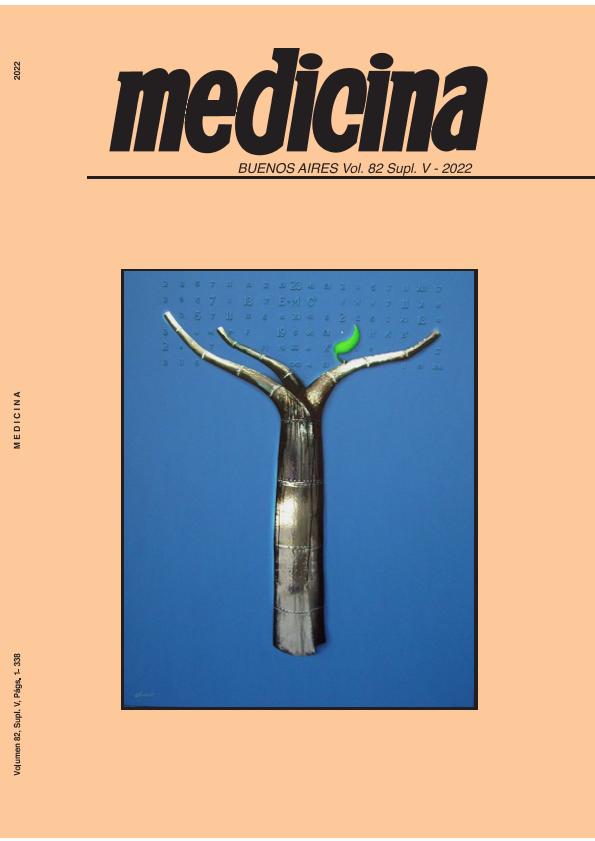Evento
Bone-vascular-adipose tissue interplay: modulation by estrogens
Cepeda, Sabrina Belén ; Sandoval, Marisa Julia; Cutini, Pablo Hernan
; Sandoval, Marisa Julia; Cutini, Pablo Hernan ; Valle, María Ivone; Campelo, Adrián Esteban
; Valle, María Ivone; Campelo, Adrián Esteban ; Massheimer, Virginia Laura
; Massheimer, Virginia Laura
 ; Sandoval, Marisa Julia; Cutini, Pablo Hernan
; Sandoval, Marisa Julia; Cutini, Pablo Hernan ; Valle, María Ivone; Campelo, Adrián Esteban
; Valle, María Ivone; Campelo, Adrián Esteban ; Massheimer, Virginia Laura
; Massheimer, Virginia Laura
Colaboradores:
Vila Petroff, Martin Gerarde

Tipo del evento:
Congreso
Nombre del evento:
Reunión Anual de Sociedades de Biociencias 2022: LXVII Reunión Anual de la Sociedad Argentina de Investigación Clínica; LXX Reunión Anual de la Sociedad argentina de inmunología; Reunión anual 2022 de la Sociedad Argentina de Fisiología
Fecha del evento:
16/11/2022
Institución Organizadora:
Sociedad Argentina de Investigación Clínica;
Sociedad argentina de inmunología;
Sociedad Argentina de Fisiología;
Título de la revista:
Medicina
Editorial:
Fundación Revista Medicina
ISSN:
1669-9106
Idioma:
Inglés
Clasificación temática:
Resumen
Nitric oxide (NO) promotes bone cells proliferation, differentiation and survival. An adequate vascularization that provides cell progenitors and hormones is required for skeletal homeostasis. The menopausal hypoestrogenism is tightly associated with bone and cardiovascular diseases, and also with changes in adipose tissue (AT) distribution. In this work we studied the role of the estrogens estradiol (E2) and estrone (E1), and phytoestrogen genistein (Gen) on bone-vascular or bone-AT interactions. Two experimental designs were employed: 1) conditioned medium obtained from endothelial cells (EC) exposed to Gen (CM-EC), or conditioned medium obtained from osteoblasts (OB) exposed to Gen (CM-OB); 2) co-cultures OB-AT. A bidirectional regulation between OB and EC was revealed. CM-EC added to OB monolayers stimulated bone cells proliferation (150% a/C, p<0.05). In the presence of NO synthase (NOS) inhibitor, NAME compound, OB growth was blunted suggesting the participation of NOS system. On the other hand, CMOB added to EC cultured enhanced EC proliferation and migration (44; 150% a/C respectively, p<0.01). Since these two events are involved in angiogenesis, tubes formation from aortic rings seeded on a collagen matrix was quantified. CM-OB induced a 0.5 fold increase (p<0.05) in tubes formation around the rings. To assess bone-AT interactions, cocultures OB-AT were used. After 3 days, E2 E1 and Gen stimulated NO production (64; 34; 37% s/c, respectively). At a longer co-culture time, a reduction in NOS activity accompanied by an increase in oxidative stress, measured as hydrogen peroxide production, was detected (1090 ± 37.1 vs 1220 ± 31.2 nmol H2O2/ mg prot, C vs E2, p<0.01). When AT slices were removed, OB diminished their capability to enhance NO synthesis and, to mineralize extracellular matrix (Alizarin staining) in response to estrogens. In summary, estrogens favour bone vascular interactions, but in the presence of AT osteoblastogenic response is delayed.
Palabras clave:
ESTROGENS
,
BONE TISSUE
,
VASCULAR TISSUE
,
ADIPOSE TISSUE
Archivos asociados
Licencia
Identificadores
Colecciones
Eventos(INBIOSUR)
Eventos de INSTITUTO DE CIENCIAS BIOLOGICAS Y BIOMEDICAS DEL SUR
Eventos de INSTITUTO DE CIENCIAS BIOLOGICAS Y BIOMEDICAS DEL SUR
Citación
Bone-vascular-adipose tissue interplay: modulation by estrogens; Reunión Anual de Sociedades de Biociencias 2022: LXVII Reunión Anual de la Sociedad Argentina de Investigación Clínica; LXX Reunión Anual de la Sociedad argentina de inmunología; Reunión anual 2022 de la Sociedad Argentina de Fisiología; Mar del Plata; Argentina; 2022; 193-193
Compartir



